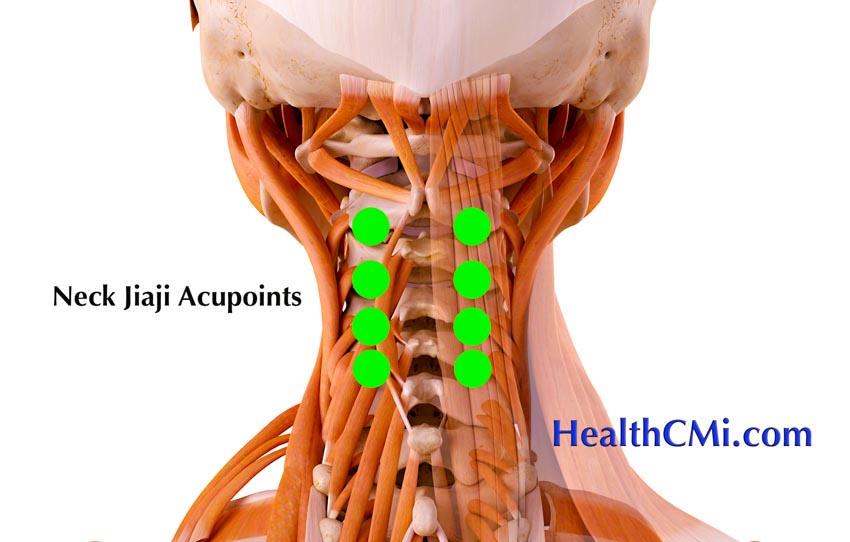Acupuncture reduces numbness, local pain, and radiating pain emanating from the neck. Heilongjiang University of Traditional Chinese Medicine researchers tested the efficacy of electroacupuncture and cervical vertebra traction therapy. Both therapies produced significant results and electroacupuncture outperformed traction across several parameters. [1]
The research focused on the application of electroacupuncture at Jiaji acupoints. This two-arm study investigated relative efficacy between electroacupuncture and cervical traction for the treatment of cervical radiculopathy. A five-part neck pain parameter, Northwick Park Questionnaire (NPQ), was adopted to measure neck pain and patient disabilities.
The score of the electroacupuncture group presented a more marked decrease (from 32.18 ±10.21 to 13.54 ±4.32) than the control group (from 31.68 ±9. 85 to 16.33 ±5.42). The McGill Pain Questionnaire (MPQ), also known as McGill Pain Index, was used to measure pain levels. The figure for the electroacupuncture group dropped from 16.23 ±4.49 to 5.32 ±1.84, while that of the traction control group showed a smaller decrease (16.51 ±3.88 to 8.20 ±2.13). Given that both independent groups demonstrated clinical improvements, we would like to see a follow-up investigation combining the two therapies into an integrated treatment protocol.
From January 2018 to December 2018, 80 cervical radiculopathy patients were included in this study. The patients were randomly classified into a cervical vertebra traction therapy control group and an electroacupuncture group, with 40 patients in each group. There was no significant statistical distinction between the two groups at the outset.
Patients met the following criteria in order to be admitted. Patients exhibited symptoms of numbness, pain, and radiating pain on one or both upper extremities. When palpating the neck and shoulder muscles, muscle stiffness and limitation of neck movement were observed. Patients complained of pain one cun away from the spine.
The results of traction testing of the brachial plexus and compression testing of the intervertebral foramen were both positive. Muscular atrophy was seen on cervical and shoulders. Tendon reflexes were weakened or disappeared. X-ray (anteroposterior and lateral films) showed a slight straightening of the cervical spine.
As for the procedure in the electroacupuncture group, patients took a prone position or a seated position. Three pairs of Jiaji points were selected in the treatment, centered on the segment of the diseased cervical spine. Filliform needles (0.35 mm × 40 mm) were inserted obliquely, 0.5 cun away from patients’ spine. Needling length was 0.8 to 1.0 cun. A mild reinforcing-attenuating needling manipulation method was utilized.
Upon achieving a deqi sensation, an electroacupuncture device was connected to the needles. A sparse wave was used. The wires were connected horizontally. The first and third pairs of Jiaji points were connected in the same direction and the second group of points’ electrodes used the opposite direction.
Intensity was set to patients’ tolerance level and muscle contraction was expected. One treatment course included 30-minute daily therapies for six consecutive days, followed by a one-day break. The clinical trial consisted of four courses of patient care.
For traction, each patient was placed in a seated position, and the muscles of the shoulder and neck were relaxed during the procedure. The patients were instructed to tilt the neck forward by 10 to 30 degrees (depending on the affected area on the cervical spine). The head was fixed with an occipital facial band, and then cervical traction was performed. The weight of traction was 1/10 of the patient's own body mass, or it could be increased or decreased according to the patient's age and severity of condition. Therapy was administered for 30 minutes on alternative days for a total of 30 days.
The results showed patients with cervical radiculopathy benefited tremendously from electroacupuncture. Both traction and electroacupuncture produced positive outcomes and electroacupuncture outperformed traction.
Reference:
[1] Wang Chunying, Sun Zhongren, Wang Linjing, Sun Xinghua, Jiang Shanshan, Clinical Observation on Treating 40 Cases with Cervicalspondylotic Radiculopathy Using Electroacupuncture on Jiaji Points, Hunan Journal of Traditional Chinese Medicine, Vol. 37 No. 10 Oct. 2021.



